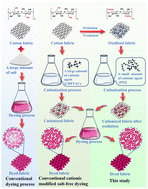Efficient cationization of cotton fabric via oxidative pretreatment for salt-free reactive dyeing with low chemical consumption
Abstract
In cotton fabric dyeing processes, a large amount of salt in conventional reactive dyeing or a large amount of cationic agent in conventional cationic-modified salt-free dyeing is consumed and remains in the effluent. Here, we introduce a clean and salt-free dyeing method with low chemical consumption, which reduces by 88.8% and 53.7% the chemicals per kilogram of cloth compared to conventional dyeing and conventional cationic-modified dyeing, respectively. This method is as simple as the introduction of a negative charge by selective oxidation before the cationization process of the cotton fabric. Benefiting from the introduced inner surface charge of the fiber, medium-Mw PEI can diffuse into the fiber interior and the adsorption amount increased by 10 times, resulting in a high dye uptake and fixation rate, uniform distribution of the dye molecules on the fibers, and good fastness comparable to conventional dyeing. The method in this study not only improves the utilization rate of cationic modifiers, but also reduces chemical consumption and dyeing cost, providing an economical and promising new method for the industrial application of cationic salt-free dyeing.



 Please wait while we load your content...
Please wait while we load your content...